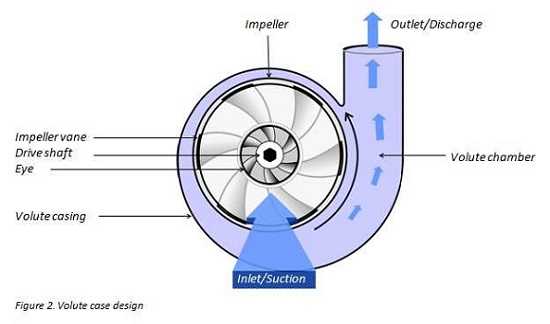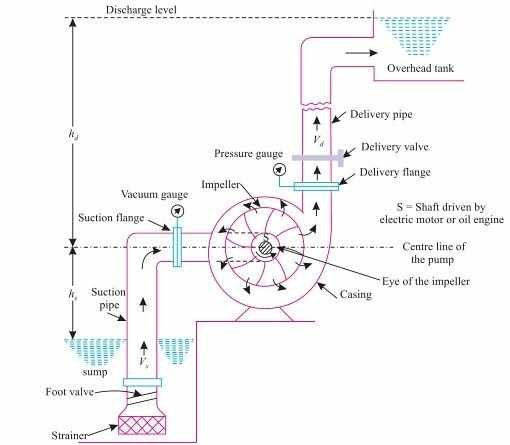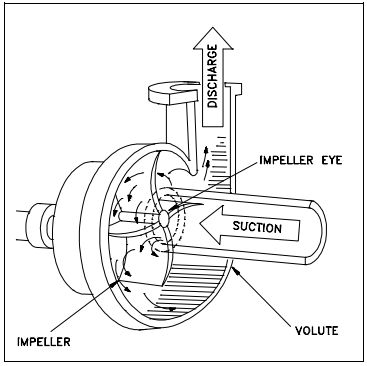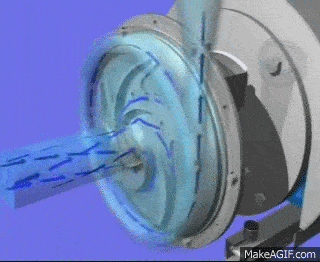Centrifugal pumps are widely used in various industries to transport fluids from one place to another. These pumps work on the principle of converting mechanical energy into hydraulic energy, which is then used to move the fluid. In this article, we are going to discuss different types of centrifugal pumps, their diagrams, and the working principle that makes them so effective.
We will also discuss what are the advantages and disadvantages of using centrifugal pumps and what are the applications of centrifugal pumps in various industries.
Pump – A pump is a mechanical device which helps in transferring a fluid from one place to another by increasing its pressure.
What is Centrifugal Pump ?
Centrifugal Pump
Centrifugal Pump is a type of rotodynamic pump in which the flow through the pump is induced by the centrifugal force imparted to the liquid by rotation of the impeller.
The centrifugal Pump operates on a rotodynamic principle in which the flow through the Pump is induced by the centrifugal force imparted to the liquid by the rotation of an impeller. Therefore it is also known as Rotodynamic Pump.

Parts of Centrifugal Pump
The main parts of centrifugal pump are:
Impeller
The impeller is the one whose rotary motion induce a centrifugal force on the fluid. The rotational components of centrifugal pump are called impellers. A shaft that is attached to an electric motor has an impeller placed on it. The impeller is rotated by the motor.
They are made of a collection of backward-curving blades and come in various sizes and forms to suit different applications and the characteristics of the pumped liquids. Depending on the chemical characteristics of the liquid being pumped, a variety of materials can be used to make the impellers. Before being put on the pumps, all impellers must be dynamically balanced.
Shaft
The impeller is mounted on a shaft and enclosed by casing. The impellers, shaft sleeves, and bearings are positioned on the shaft of a centrifugal pump, which is the central portion of the rotor. The shaft receives mechanical energy from the motor. The impeller rotates with the help of the shaft.
Casing
Casing is the stationary part of the centrifugal pump which acts as housing to all the internal parts and protects them from external atmosphere. This is an airtight passage that surrounds the impeller. It is constructed in such a manner that, before the water exits the casing and enters the delivery pipe, the kinetic energy of the water is converted to pressure energy. The casing converts velocity imparted by impeller to the water in a steady flow.

Volute Casing
This is so named because of its spiral shape which is so constructed to convert the part of the velocity of the fluid to the pressure energy, which is the objective of a pump , to increase the fluid’s pressure.
Some of the centrifugal pump also uses diffuser in addition to the volute casing.
Diffuser in a centrifugal pump
The diffuser performs the same function as volute casing i.e. convert part of K.E energy of the fluid to the pressure energy. It consists of a ring of guide passages around the impeller. This design is used for high pressure as in multi-stage boiler feed pump.
The diffuser-type casing’s construction enables water exiting the impeller to enter the guiding blades shock-free. The area of water flowing between the blades increases, slowing the flow rate and raising the pressure of the fluid. After the guide blades, water passes through the surrounding casing which is typically kept concentric with the impeller.
Eye Of The Impeller
In the centre of the centrifugal pump impeller, is the eye of the impeller which receives inlet flow of liquid into the vanes of the impeller.
Suction Pipe with Foot Valve And Strainer
A pipe whose one end is connected with the inlet of the impeller and the other end is dipped into the sump of the water is called suction pipe. The suction pipe consists of a foot valve and strainer at its lower end. The foot valve is a one way valve that opens in the upward direction so that the water does not flow back to the supply side when the pump is not in the operation. The strainer is used to filter the unwanted particles present in the water to prevent the centrifugal pump from blockage.
Bearings in Centrifugal Pump
The purpose of the bearings is to maintain the shaft or rotor’s proper alignment with the stationary components when radial and axial loads are applied. The two different types of Bearings are used used in centrifugal pump are Line Bearings and Thrust Bearings. Line bearings provide radial positioning to the rotor while Thrust bearings place the rotor in axial position. In many cases, the thrust bearings function as both thrust and radial bearings.
Sealing Arrangements
As the spinning shaft travels through the stationary casing of the centrifugal pump, the sealing arrangement is a component that seals the shaft. It limits the amount of fluid leakage into the atmosphere or the entry of outside air while reducing the wear on the sealing faces.
Delivery Pipe
Delivery pipe is the pipe whose one end is connected to the outlet of the pump and the other end is connected to the required height where water is to be delivered.

Also Read : Difference Between 2 Stroke and 4 Stroke Engine
Centrifugal Pump Working Principle

The working principle of a centrifugal pump involves the conversion of mechanical energy into hydraulic energy, which is then used to move the fluid.
The rotation of the centrifugal pump impeller causes the liquid it contains to move outward from the center to beyond the circumference of the impeller because of the centrifugal effect. And because of this movement of the fluid to the outer periphery, there is a drop of pressure at the eye of the impeller. This drop in pressure creates the suction force of the pump and hence the pump draws the fluid from the suction supply.
Now, the water due to centrifugal force continue to move towards the casing. The area of casing increases gradually in the direction of rotation. So the velocity of the water keeps on decreasing and the pressure increases and at the outlet of the pump the pressure is maximum. From the outlet of the pump, the water goes to its desired location through delivery pipe.
Overall, the working principle of a centrifugal pump involves the creation of a low-pressure zone at the center of the impeller, the transfer of kinetic energy from the impeller to the fluid, and the conversion of kinetic energy into pressure energy through the volute casing.

Working of Centrifugal Pump : Detailed Explanation
Read More : What is Caustic Embrittlement ?
Priming of Centrifugal Pump
One important thing is to note that the centrifugal pump is not self-priming. So in order to make it functional it needs to be primed.
What is meant by priming in centrifugal pump?
Priming is the process in which the suction pipe , casing, and delivery pipe up to the delivery valve is filled completely with liquid to be raised, from outside source before starting the pump.
Why does a centrifugal pump need priming?
Priming of centrifugal pump is done to remove the air from the pump. If the air is not removed from the pump then only a small negative pressure is created at the suction pipe and it cannot suck the water from the water sump.
Types of Centrifugal Pumps
Centrifugal Pumps are classified into many types based on many categories, they are
Based on number of impellers in the pump,
- Single stage pump
- Two-stage pump
- Multi-stage pump
Based on orientation of case-split,
- Axial split Pump
- Radial split Pump
Based on type of impeller design,
- Single suction Pump
- Double suction Pump
Based on the basis compliance with industry standards,
- ANSI pump – (American National Standards Institute)
- API pump – (American Petroleum Institute)
- DIN pump – DIN 24256 specifications
- ISO pump – ISO 2858, 5199 specifications
- Nuclear pump – ASME (American Society of Mechanical Engineers) specifications
Based on type of volute
- Single volute Pump
- Double volute Pump
Based on where the bearing support is,
- Overhung
- Between-bearing
Based on on shaft orientation
- Horizontal Pump
- Vertical Pump
What are the Advantages of Centrifugal Pump?
The centrifugal pump has following advantages:
- Multiple uses: Centrifugal pumps are frequently employed in a variety of processes, including the provision of water, the treatment of wastewater, chemical processing, and the manufacture of petroleum.
- Simple design: Centrifugal pumps have a straightforward design that makes them simple to use, maintain, and fix.
- High flow rates: Centrifugal pumps are suitable for many industrial applications because they can handle enormous volumes of fluid at high flow rates.
- Energy efficiency: Centrifugal pumps typically use less energy than other types of pumps, which over time can save you a lot of money.
What are the Disadvantages of Centrifugal Pump?
The centrifugal pump has following disadvantages:
- Limited suction lift: Centrifugal pumps may not be able to raise fluids from deeper levels due to their limited suction lift.
- Poor performance when pumping viscous fluids: Because of the high velocity of the fluid and the potential for aerated or frothy fluid, these pumps are not recommended for pumping viscous fluids, such as oils or syrups.
- Reduced efficiency at low flow rates: This could lead to increased energy expenses when it experiences reduced efficiency at low flow rates.
- Cavitation risk: Cavitation, which happens when the pressure inside the pump falls below the vapour pressure of the fluid, can potentially harm centrifugal pumps by causing bubbles to form.
Why start centrifugal pump with discharge closed?
By closing the discharge valve, we can reduce the starting current.
As we know that, the current will be high during the starting of any motor. If we start the pump with the discharge valve open, The discharge head will act on the pump i.e. more resistance, so the motor has to give more starting torque to the pump which means more current is drawn by the motor.
In other words, if there is pressure in discharge side of the pump , prior to startup, it can flow back through the pump, causing a backward spin and may draw more current, thereby causing damage to the pump.

Suggested Read : Easiest Method To Calculate Brake Horse Power
Cavitation in Centrifugal Pump
During operation if the drop in the pressure created at the suction side of a centrifugal pump (by liquid moving radially outwards from the eye of the impeller) is greater than the vapor pressure for the temperature at which liquid being pumped, the vapor / bubbles will be drawn from the liquid in this area.
Any vapour bubbles formed by the pressure drop at the eye of the impeller are swept along the impeller vanes by the flow of the liquid. When the bubbles enter from low pressure to high pressure farther out the impeller vanes, they abruptly collapse. The process of the formation and subsequent collapse of the vapor bubbles in a pump is called cavitation.
This phenomenon is likely to occur if there is a restriction in the suction pipe, or if the liquid is volatile, or has a higher temperature than anticipated, or if the impeller speed is excessive.
Cavitation degrades the performance of the pump, resulting in a fluctuating flow rate and discharge pressure. It can also be destructive to the pump’s components as collapsing of bubbles on impeller vanes can damage the blades. It can also cause excessive pump vibration which could damage pump bearings, wearing rings and seals.

Read About : Bulwark Definitions Meaning
Net Positive Suction Head
It is the difference between inlet pressure and the lowest pressure level inside the pump. It is therefore an expression of the pressure loss that takes place inside the first part of the pump housing.
Required NPSH is the lowest inlet pressure required by the specific pump at a given flow to avoid cavitation.
Available NPSH is the absolute pressure at the suction part of the pump.
Pump will operate only if:
( required NPSH > Available NPSH )
Vapour Pressure
It refers to the pressure at which the vapour and liquid phases are in equilibrium .
Suction Lift
Suction lift exists when the source of supply is below the center line of the pump. Thus, static suction lift is the vertical distance from the center line of the pump to the free level of the liquid to be pumped.
Suction Head
Suction Head exists when the source of supply is above the center line of the pump. Thus, static suction head is the vertical distance from the centerline of the pump to the free level of the liquid to be pumped .
Static Discharge Head
It is the vertical distance between the center line and the point of free discharge or the surface of the liquid in the discharge tank.
Total Static Head
It is the vertical distance between the free level of the source of supply and the point of free discharge or the free surface of the discharge liquid.
Friction Head
It is the head required to overcome the resistance to flow in pipe and fittings. Depends on the size, type of pipe, flow rate and the nature of the liquid.
Some Other Topics : What are the various Boiler Mountings ?
Crankcase Explosion – Occurrence, Prevention, Precautions
FAQs : Centrifugal Pump
What is centrifugal pump and how it works?
It is a device which is used to transfer Liquid From suction to discharge with the help of rotational energy. The centrifugal Pump operates on a rotodynamic principle.
What are the 3 types of centrifugal pumps?
1. Single Stage
2.Two-stage
3. Multi-stage
What does a centrifugal pump do?
It is a mechanical device which is used for transfer liquids from one place to another by increasing its pressure.
What is priming of a pump?
Priming is the process in which the suction pipe , casing, and delivery pipe up to the delivery valve is filled completely with liquid to be raised, from outside source before starting the pump.
What is centrifugal pump used for?
Centrifugal pumps are widely used for fluid transport in a wide range of industries including wastewater treatment, water supply, chemical processing, oil and gas transport, food and beverage processing and HVACs systems.
Which motor is used in centrifugal pump?
DC shunt motor because it runs at constant speed. As a result, it is employed for operating centrifugal pumps, lathes, constant speed line shafts, tiny printing presses, and other machinery.
What is difference between pump and centrifugal pump?
A pump is a device used to move fluids (liquids or gases) from one place to another, while a centrifugal pump is a specific type of pump that uses a rotating impeller to increase the velocity of a fluid and then transfer it to a another location.
Essentially, all centrifugal pumps are pumps, but not all pumps are centrifugal pumps. Other types of pumps are positive displacement pumps, axial flow pumps, and mixed flow pumps.
Why is it called centrifugal pump?
The term “centrifugal” in the name of the pump refers to the centrifugal force that is generated by the rotation of the impeller. Rotation of the impeller creates a centrifugal force that creates a pressure differential, which in turn causes the fluid to move through the pump and out of the discharge port.
Check Out Other Important Topics
| IC Engine | Important PDFs | Boilers | Synergy Maritime Exam | Naval Arch | MEO Class 4 |
| Interview Questions | Difference Between | Types of Pumps | Auxiliary Machines | Types of Valves | Home |
If you are in search of a pump for chemical dosing, You can get your chemical dosing pumps in Saudia Arabia from Ejawda.


